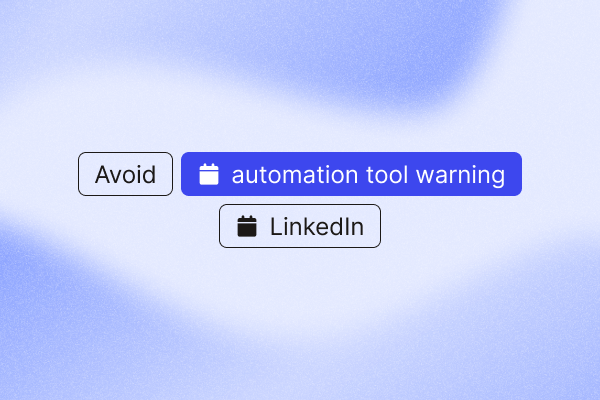LinkedIn will send warnings when its system notices unusual automated activities in your account.
We’ve seen cases where users were flagged for as little as browsing too many profiles in one session. The result? Account restrictions that could’ve been avoided.
Adhering to LinkedIn’s rules is essential to prevent account restrictions and ensure compliance with their terms of service.
In this guide, we explain why LinkedIn flags certain behaviors and how you can avoid them by automating tasks responsibly.
What is LinkedIn automation?
LinkedIn automation refers to the use of software or tools to automate repetitive tasks on the LinkedIn platform. This can include sending connection requests, messages, and endorsements, scraping data, and automating interactions.
How does LinkedIn detect automation tools?
LinkedIn’s algorithm quickly detects suspicious or unusual activity by monitoring behavior that doesn’t match how a real person would use the platform. Users need to change their behavior and strategies to avoid issues with their LinkedIn accounts.
For example, sending too many connection requests at once and too many LinkedIn messages in a short span. Additionally, LinkedIn may issue warnings if users receive multiple “Not Knowing You” reports.

This is part of LinkedIn’s effort to uphold a professional environment by closely monitoring user activity.
Here are more actions that trigger the LinkedIn automation tool warning:
| Action | Why might this trigger a LinkedIn warning? |
| Rapid profile viewing | Browsing 100+ profiles in minutes mimics scraping behavior. LinkedIn doesn’t like it because of the platform’s integrity. |
| Unnatural time patterns | Using LinkedIn non-stop or at odd hours can make you look like a bot operator. |
| High connection request volumes | Sending hundreds of connection requests to prospects quickly can break limits. |
| Inconsistent logins | Switching devices, IP addresses, or browsers too often may trigger location-based flags. |
| Unethical use of browser extensions | Some Chrome extensions inject code into LinkedIn’s interface to extract data. These are easily tracked by LinkedIn and flag your account. |
Once LinkedIn detects these triggers, it may take a range of actions depending on the severity:
- Soft warnings: You might see messages like “You’re visiting too many profiles.”
- Restricted features: LinkedIn can temporarily stop you from sending connection requests or messages.
- Account suspensions: In more serious cases, your account may be temporarily restricted or permanently banned. The rule of thumb in temporary restriction cases is not to create another account with the same email. Avoid using LinkedIn manually during automated tasks to prevent account restrictions.
Common LinkedIn warning messages
A warning from LinkedIn is the first sign that your account has been engaging in actions that don’t align with LinkedIn’s rules. Pay attention to these warnings to avoid further issues.
LinkedIn uses system-generated messages to alert you when an activity crosses a line.
Here are some common warning messages users report seeing:
LinkedIn warning messages: “We’ve restricted your account temporarily”
This is the most serious warning. LinkedIn may temporarily limit features like messaging, connecting, or posting while it reviews your activity.
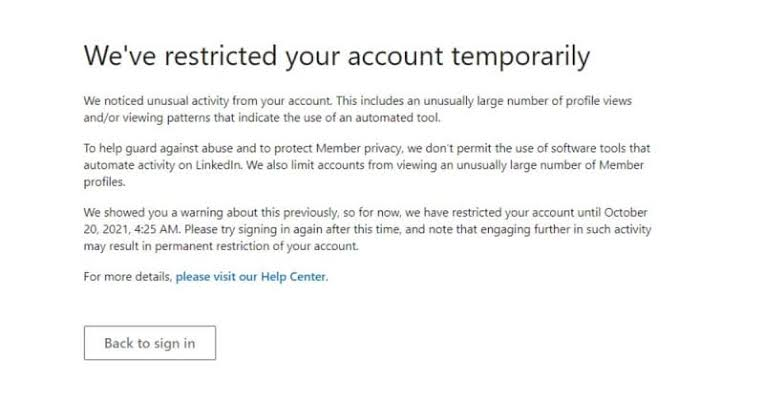
LinkedIn flags unnatural behavior, such as sending more than 100 connection requests in a week or browsing profiles too quickly.
Don’t create a new account with the same Gmail if you get a warning.
First, pause all automation, then contact LinkedIn support.
To initiate an appeal, log into your account and respond to notifications regarding the restriction. Be concise, patient, and polite when communicating with LinkedIn Support to increase the chances of a successful appeal.
LinkedIn warning messages: “Important notice from LinkedIn” or “Something isn’t quite right”
This notification means you’re visiting profiles too quickly or were triggered by unusual activity.
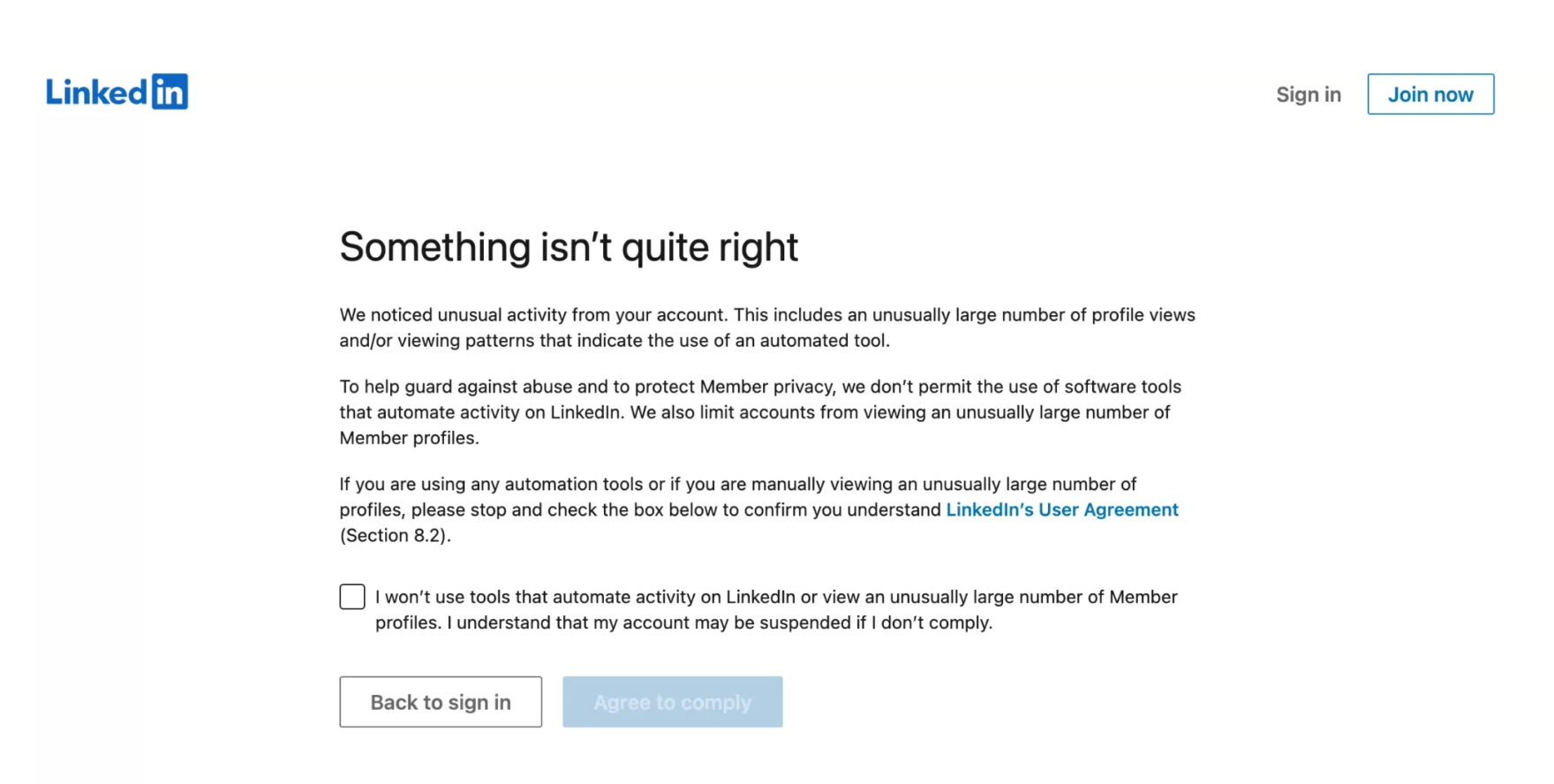
For example, you’re clicking through multiple profiles in a short period.
If you scrape data often, you may get this warning as it violates LinkedIn’s commercial policy. It’s advisable to limit profile views to approximately 500 per day for standard accounts and up to 1000-2000 per day for Sales Navigator accounts.
A similar warning might also come when you’re using Chrome Extensions that are not safe.
As this is just a LinkedIn automation warning, you only have to click Agree to comply and can continue to use your account. We recommend pausing all automated activity if you receive this warning.
LinkedIn warning messages: “You’ve reached the weekly invitation limit”
LinkedIn sets a hard limit of around 100 connection requests per week. Once you hit that cap, you won’t be able to send more until the limit resets — usually after 7 days. This restriction applies to both manual and automated outreach, and ignoring it increases your risk of account warnings or restrictions.
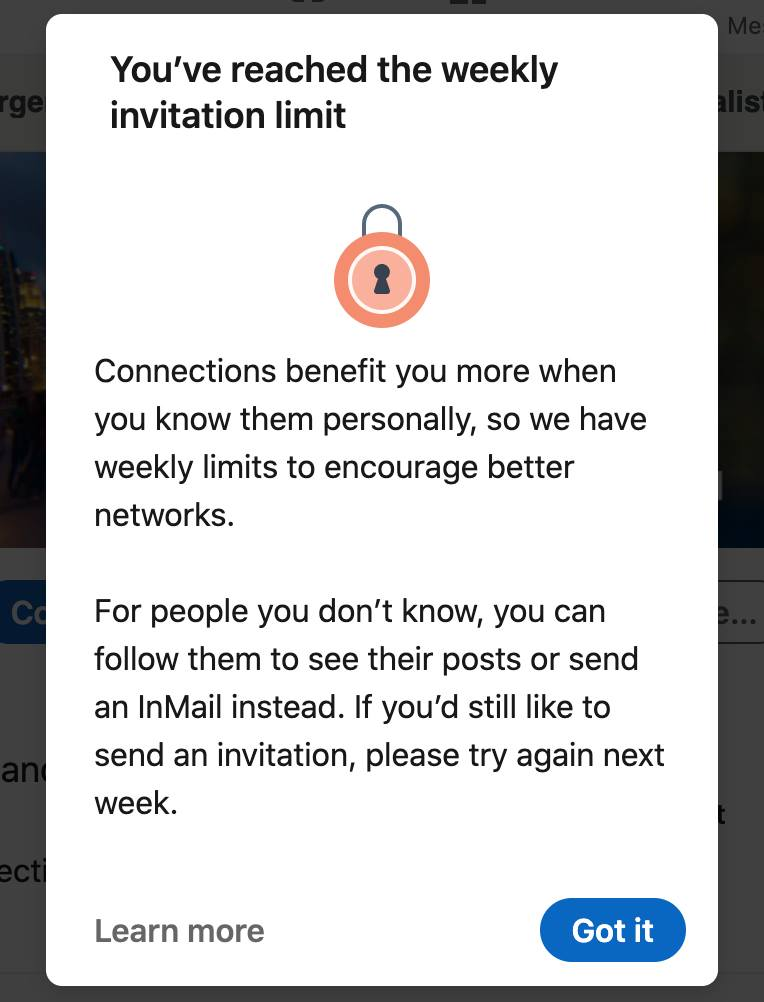
To effectively deal with the weekly invitation limit, plan your connection requests strategically and follow up with prospects to ensure your marketing efforts are not wasted.
How to avoid LinkedIn automation tool warnings
You can use automation tools on LinkedIn without risking your account if your LinkedIn activity follows platform-friendly instructions. Here’s how to stay compliant while still getting results:
| Best practice | What to do |
| Stick to LinkedIn limits | Keep connection requests under 100 per week to avoid hitting LinkedIn connection limits. |
| Automate like a human | Add 30–60 second delays between actions. Avoid patterns that look fast or repetitive. |
| Avoid bulk scraping | Don’t scrape large volumes of data. Apply filters when scraping profiles to avoid triggering LinkedIn’s bots and focus on relevant, high-quality leads. |
| Use tools with LinkedIn-approved APIs | Choose platforms like PhantomBuster’s LinkedIn Profile Scraper, which follows LinkedIn’s API guidelines and allows safe, compliant automation. |
| Use a consistent setup | Run automation from the same browser or proxy to keep login activity stable and avoid suspicious login flags. |
| Leverage LinkedIn features manually | Cancel pending invites or manually send connection requests to maintain effective user engagement on the platform. |
| Use safe browser extensions | Use PhantomBuster’s Chrome extension that mimics human behavior and can help you build targeted lead lists while browsing LinkedIn, without triggering bot activity or suspicious behavior. |
What to do if you receive a LinkedIn warning
A LinkedIn warning isn’t the end of the road. Look at it as a prompt to pause, adjust, and seek support from LinkedIn. Here’s how to recover your account:
Steps to handle a LinkedIn warning:
Pro Tip: Once you get a warning message, take a screenshot of it so it can serve as proof when you contact LinkedIn’s support team. Make your complaint message clear, specific, and straight to the point.
- Pause all automation:
- Stop using automation tools for a few days.
- Contact LinkedIn support if the account isn’t unlocked automatically.
- Even tools that adhere to best practices can trigger warnings if overused.
- Withdraw pending invitations:
- Navigate to the “Sent Invitations” tab and cancel pending connection requests.
- Managing these interactions helps maintain client relationships and ensures automation does not impact your ability to connect with potential clients.
Tip: Automate withdrawing connection invites using PhantomBuster’s LinkedIn Auto Invitation Withdrawer automation.
- Disable extensions:
- Clear browsing data and disable LinkedIn-related browser extensions.
- This action helps unlink any behavioral patterns associated with automation.
- Return to manual activity:
- Log in directly and use LinkedIn manually and responsibly.
- Slow down your pace, engage with content, and send fewer messages.
- Stay updated with LinkedIn’s terms to understand what’s allowed and risky. Adhering to these guidelines keeps your account safe long-term.
You can still send contacts from LinkedIn to HubSpot or build lists while using a safe Chrome Extension like PhantomBuster, which doesn’t run in the background and is only triggered by manual activity.
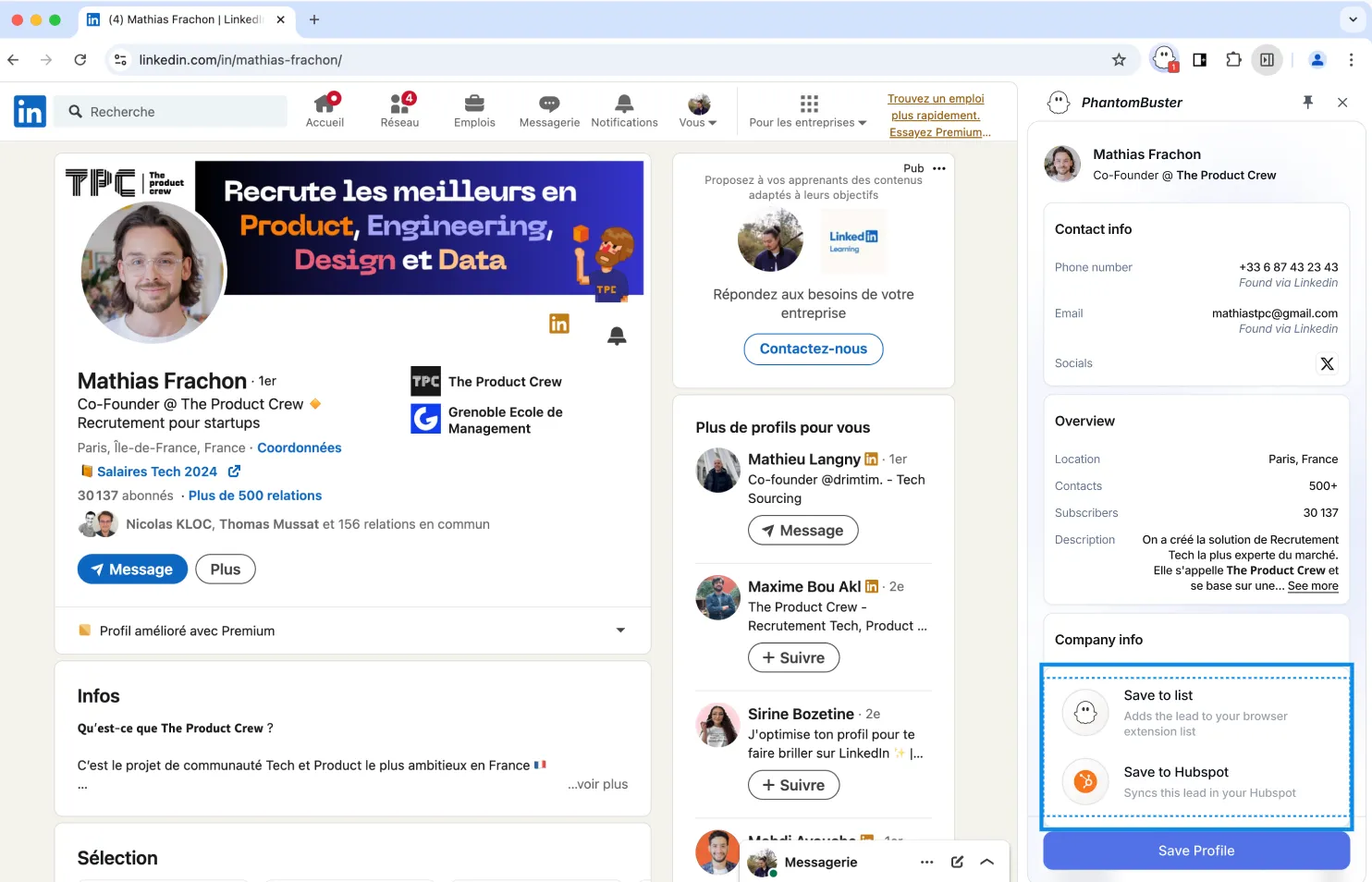
LinkedIn’s policies on commercial use limits
LinkedIn’s commercial policy states, “If you reach the commercial use limit for searching, your activity on LinkedIn indicates that you’re likely using LinkedIn for commercial use, like hiring or prospecting.”
User activities on LinkedIn pages and automated actions contribute to reaching the usage limits on your personal account. Some of these limits include:
| Activity | Limit |
| Connection invites | 100 per week |
| Invitation messages | 1–2 per week |
| Direct messages | 100 per week |
| InMails (free accounts) | 0 |
| Profile views | 80 per day |
If you hit these limits repeatedly, you may see warnings. In more serious cases, ignoring the warnings can result in a permanent ban. Creating a new account traced back to the same IP address can also lead to scrutiny and potential account bans.
How to safely use automation tools on your LinkedIn account
You can use automation tools on LinkedIn if your actions stay within human-like limits. Here are best practices on how to do it safely:
- Keep your activity volume in check: Stay below 100 weekly connection requests and less than 150 messages daily. High volume is one of the fastest ways to get flagged. Focus on meaningful connections.
- Add natural pauses between actions: Set delays of 5–30 seconds between profile visits, messages, or requests. Randomized gaps help your activity look human.
- Warm up new accounts slowly: Once you create a new account or new LinkedIn page, start with light activity and gradually increase as your account builds credibility. Accounts with a higher SSI score can automate more than new accounts or accounts with no activity.
- Avoid running automation non-stop: Take breaks between sessions. Humans don’t work in perfect, 24/7 cycles — neither should your tools.
- Engage with content regularly: Like, comment, and share posts to show you’re active beyond prospecting. LinkedIn rewards accounts that contribute, not just connect.
- Personalize automated messages: Customizing your automated messages can significantly increase response rates and make your outreach more effective. Monitoring your LinkedIn activity analytics can also assist in tracking success and making necessary adjustments to improve your strategy. Monitoring behavior is crucial as it serves as a measure to maintain account safety and compliance with LinkedIn’s guidelines.
Browser extensions vs. cloud-based tools: Which is safer for LinkedIn automation?
Here’s a side-by-side table comparison of browser-based vs. cloud-based LinkedIn automation tools. This comparison is perfect for sales reps or anyone weighing their options.
Specific third-party tools or applications can automate LinkedIn activities, but if they trigger notices about automation, they may result in account restrictions.
| Feature | Browser-Based Tools | Cloud-Based Tools |
| Tool | Dux-Soup, Linked Helper, Meet Alfred, Octopus CRM | Phantombuster, Zopto, Expandi, Dripify |
| How They Work | These tools run in your browser and mimic manual actions like sending requests or viewing profiles. | These tools run in the cloud, automating tasks in the background without needing LinkedIn open in your browser. |
| Installation | Chrome extension or browser plugin | Web app or cloud dashboard plus Chrome Extension to facilitate scaling manual activities |
| Detection Risk | 🔴 High – LinkedIn can detect extensions and suspicious browser activity | 🟢 Low–Medium – Uses proxy IPs, random delays, and mimics human timing |
| 24/7 Operation | ❌ No – stops when browser closes | ✅ Yes – runs even when your browser is closed |
| Ease of Use | ✅ Easy setup, intuitive UI | ✅ Easy setup, intuitive UI |
| Scalability | ❌ Limited – tied to your browser/device | ✅ High – great for teams, agencies, and large-scale outreach |
| Safety Features | ⚠️ Basic (if any) – relies on user caution | ✅ Advanced: Random delays, throttling, time zones, etc. |
| Pros | – Easy to install and use – Real-time control – Good for small campaigns |
– Harder to detect – Runs in background – Highly scalable – Designed for B2B and agency workflows |
| Cons | – High detection risk – Limited safety tools – Can’t run in background |
– Costs more – Setup can take longer – Still not 100% safe (but safer) |
| Best Use Case | Freelancers or small businesses doing light outreach | Sales reps, B2B marketers, doing structured or scaled LinkedIn prospecting |
Safe and compliant cloud-based tools for Sales Reps
| Tool | Key Features | Safety | CRM Integrations | Pricing |
| Phantombuster | Sales prospecting, ICP sales, automation, automation workflows, no-code automation | 🔐 High (runs in cloud) | ✅ Bi-directional with Hubspot ✅ Lemlist, Hunter.io ✅ Zapier, Make ✅ Snov.io | $56/mo |
| Expandi | Smart inbox, dynamic personalization, advanced targeting | 🔐 High (random delays, proxy IPs) | ✅ HubSpot, Zapier, | $99/mo |
| Dripify | All-in-one sales automation with built-in inbox | 🔐 High | ✅ CRM, Google Sheets, Zapier | $39/mo |
| Zopto | Enterprise-level campaigns, high volume | 🔐 High | ✅ Salesforce, HubSpot, | ~$215/mo |
We recommend gradually increasing your activity levels and adjusting your settings to enhance your user experience and safety on LinkedIn.
